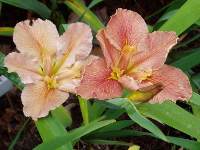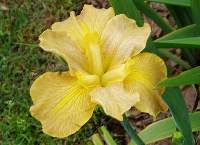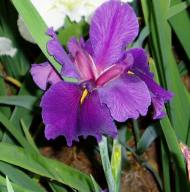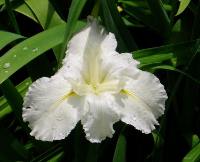 The Louisiana Iris Suite
The Louisiana Iris SuiteImages and reflections by Dick Sloan
Above is 'Lafayette Honey', Dorman Haymon of Duson, near Lafayette, LA,, 1999. Some people don't care for brown flowers, but I like them and both irises and daylilies have beautiful brown cultivars. Several older Louisianas, such as Arny's 'Dean Lee', are still beautiful, but we have two excellent new, fancier flowered entries. 'Lafayette Honey' opens with considerable yellow in the flower, as shown in the picture. As the bloom matures the yellow disappears and the flower is a true brown. It's a very nice somewhat shorter statured plant, perhaps 30".
Ron Betzer's 'Honey Galore', 1999, is much this same color
and retains the same tint throughout its bloom life. It is about
the same stature. In bloom at Marie Caillet's guest beds, during
the 2000 American Iris Society convention, it had five open blooms
on a stalk. It was the first time I'd ever seen so many open
at once, and stalks with five bud positions are rather uncommon.
 'Praline
Festival', Haymon 1992, just won the Debaillon Medal of the
AIS. Their highest award is the Dykes Medal, named for W.R. Dykes
who in 1913 published his monograph The Genus Iris. This volume,
large in both size and content, was published by Cambridge. It
contains superb color illustrations of the species. Copies now
sell in the $1500 and up range. A smaller sized reprint was published
some years ago by Dover, and is available at more reasonable
prices. Dykes obtained two seedlings from I. fulva crossed
with I. brevicaulis and named them in 1910, Fulvala and
Fulvala Violacea. Much of this same breeding was used years later
by Frank Chowning. Dykes died young. The American Iris Society
is primarily concerned with tall bearded irises so no Louisiana
is ever likely to win this medal, which is authorized by the
British Iris Society for annual awards to British, Australian
and American irises. Prior to WWII they were also awarded in
France. However, the AIS does award other classes of irises medals
and the highest, beneath the Dykes, for a Louisiana is the Debaillon
medal.
'Praline
Festival', Haymon 1992, just won the Debaillon Medal of the
AIS. Their highest award is the Dykes Medal, named for W.R. Dykes
who in 1913 published his monograph The Genus Iris. This volume,
large in both size and content, was published by Cambridge. It
contains superb color illustrations of the species. Copies now
sell in the $1500 and up range. A smaller sized reprint was published
some years ago by Dover, and is available at more reasonable
prices. Dykes obtained two seedlings from I. fulva crossed
with I. brevicaulis and named them in 1910, Fulvala and
Fulvala Violacea. Much of this same breeding was used years later
by Frank Chowning. Dykes died young. The American Iris Society
is primarily concerned with tall bearded irises so no Louisiana
is ever likely to win this medal, which is authorized by the
British Iris Society for annual awards to British, Australian
and American irises. Prior to WWII they were also awarded in
France. However, the AIS does award other classes of irises medals
and the highest, beneath the Dykes, for a Louisiana is the Debaillon
medal.
 'Bubble
Gum Ballerina', Haymon 1989, was named to honor a granddaughter.
It is a vigorous rose pink -- he registered it as lavender pink,
but I say rose pink. One of the parents was a seedling resulting
from a cross of 'Faenelia Hicks' and 'Marie
Caillet'. I love the name 'Faenelia Hicks'. She was also
a professor at the university in Lafayette, and shared an office
with Marie, being drawn into the society as a result. I enjoyed
driving her up from Lafayette to Marie's in north Texas a few
years ago. Her company made the time fly during the miles. She
is another deceased member and I miss her. The iris named for
her was registered by Charles Arny in 1969, a medium rose self
that still appears in gardens.
'Bubble
Gum Ballerina', Haymon 1989, was named to honor a granddaughter.
It is a vigorous rose pink -- he registered it as lavender pink,
but I say rose pink. One of the parents was a seedling resulting
from a cross of 'Faenelia Hicks' and 'Marie
Caillet'. I love the name 'Faenelia Hicks'. She was also
a professor at the university in Lafayette, and shared an office
with Marie, being drawn into the society as a result. I enjoyed
driving her up from Lafayette to Marie's in north Texas a few
years ago. Her company made the time fly during the miles. She
is another deceased member and I miss her. The iris named for
her was registered by Charles Arny in 1969, a medium rose self
that still appears in gardens.
 'Great
White Hope' is a 1999 introduction by Dorman Haymon, of near
Lafayette, LA. The story behind the name is interesting. About
100 years ago, Jack Johnson, an African-American, was the first
black World Heavy-weight Boxing Champion. The promoters of the
time had as a main focus, finding a white boxer who could beat
him -- the Great White Hope. An interesting movie is available
on VHS and DVD. So we have a near black iris with a name that
always needs explaining. It is a tall, strong plant, presumably
like the man. I grow it with a lovely white from Australia, 'Dural White Butterfly'.
They bloom at the same time here, making a great contrast.
'Great
White Hope' is a 1999 introduction by Dorman Haymon, of near
Lafayette, LA. The story behind the name is interesting. About
100 years ago, Jack Johnson, an African-American, was the first
black World Heavy-weight Boxing Champion. The promoters of the
time had as a main focus, finding a white boxer who could beat
him -- the Great White Hope. An interesting movie is available
on VHS and DVD. So we have a near black iris with a name that
always needs explaining. It is a tall, strong plant, presumably
like the man. I grow it with a lovely white from Australia, 'Dural White Butterfly'.
They bloom at the same time here, making a great contrast.
From The Heart | Contrasts | The Arkansas Hybridizers | From Australia
The Ladies | Hues | The Haymon Irises | The Species
My Introductions, Hybridizing, Seeds & Seedlings
Profile - Dick Sloan

